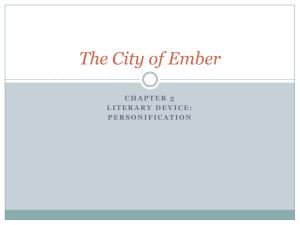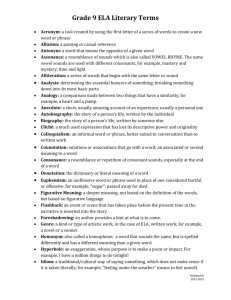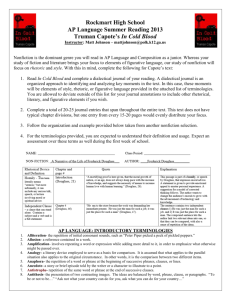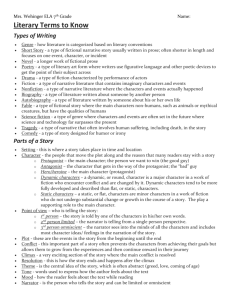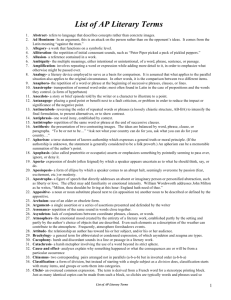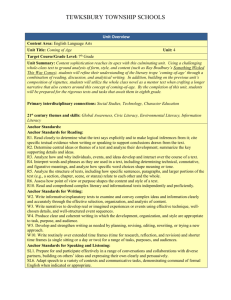Literary Devices Dictionary for English 11
advertisement
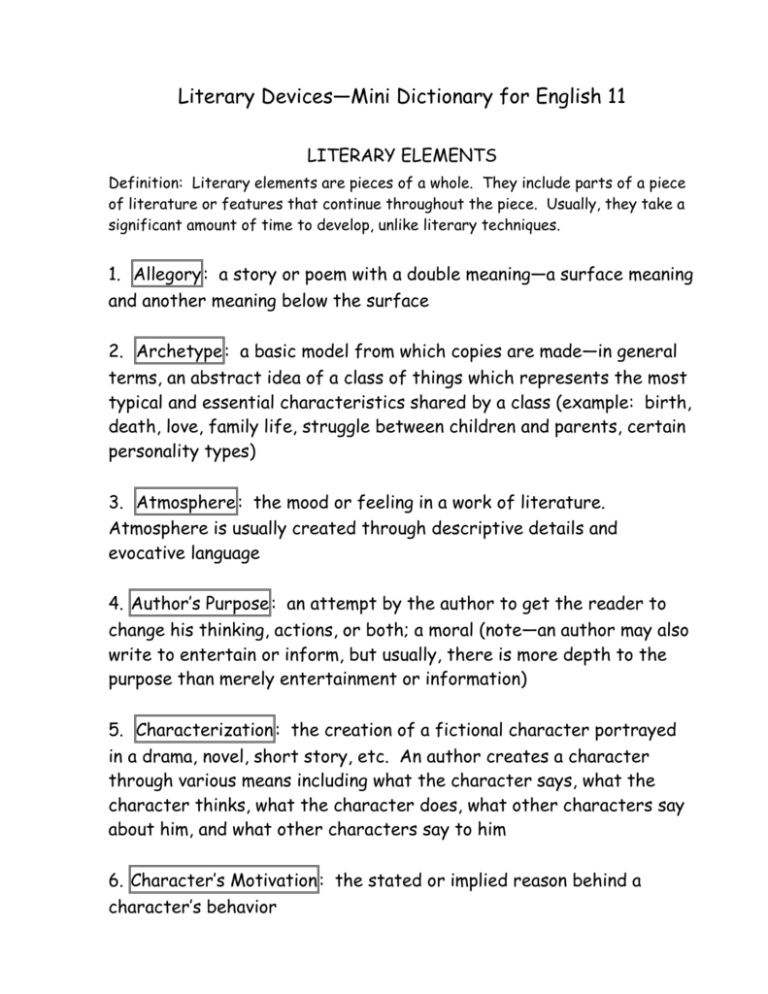
Literary Devices—Mini Dictionary for English 11 LITERARY ELEMENTS Definition: Literary elements are pieces of a whole. They include parts of a piece of literature or features that continue throughout the piece. Usually, they take a significant amount of time to develop, unlike literary techniques. 1. Allegory: a story or poem with a double meaning—a surface meaning and another meaning below the surface 2. Archetype : a basic model from which copies are made—in general terms, an abstract idea of a class of things which represents the most typical and essential characteristics shared by a class (example: birth, death, love, family life, struggle between children and parents, certain personality types) 3. Atmosphere : the mood or feeling in a work of literature. Atmosphere is usually created through descriptive details and evocative language 4. Author’s Purpose : an attempt by the author to get the reader to change his thinking, actions, or both; a moral (note—an author may also write to entertain or inform, but usually, there is more depth to the purpose than merely entertainment or information) 5. Characterization : the creation of a fictional character portrayed in a drama, novel, short story, etc. An author creates a character through various means including what the character says, what the character thinks, what the character does, what other characters say about him, and what other characters say to him 6. Character’s Motivation : the stated or implied reason behind a character’s behavior 7. Conflict : the tension between or the actual opposition of characters 8. Climax : the point of the highest tension or the dramatic turning point in a work of fiction 9. Denouement : the final unraveling of a plot’s complications at the end of a play or story—at this point, also, any mysteries are solved and any secrets are explained 10. Falling Action : the part of a play which follows the climax 11. Flashback : interruption of chronological sequence by interjection of events of earlier occurrence 12. Foreshadowing: the technique of arranging events and information in a narrative in such a way that later events are prepared for 13. Frame Story : a story that contains another story (story within a story) 14. Meter: the repetition of a regular rhythmic unit in a line or poetry. Each unit--known as a foot--has one stressed syllable and one or more unstressed syllable(s) 15. Plot : the plan, design, or pattern of events in a play, poem, or work of fiction; the organization of incident and character in such a way as to induce curiosity and suspense 16. Rising Action : the part of a play or story which precedes the climax 17. Satire : a work that exposes, censures, mocks, or ridicules the follies, vices, and shortcomings of society and which brings contempt to something that does not meet a societal norm 18. Stream of Consciousness : in a fictional work, the reader is exposed to a multitude of thoughts and feelings which pass through the character’s mind 19. Setting : the where and when of a story or play; the locale 20. Style: the distinctive way in which a work of literature is written; style refers not so much to what is said, but how it is said; word choice, sentence length, tone, imagery, and use of dialogue all contribute to a writer’s style 21. Theme : a central idea or truth about life or people (Example— greed is destructive or too much pride leads to one’s fall) 22. Tone : the reflection of a writer’s attitude, manner, mood, feelings, or moral outlook in his work--even, perhaps, the way his personality pervades the work 23. Viewpoint : the position of the narrator in relation to his story; thus the outlook from which the events are related—this includes: A. Omniscient—author moves from character to character, place to place, and episode to episode with complete freedom B. Third Person—author chooses a character and the story is related in terms of that character in such a way that the field of vision is confined to him or her alone. C. First Person Narrative—the story is told in the first person by one of its characters LITERARY TECHNIQUES Definition: Literary techniques consist of fancy, creative, or unusual use of words, phrases, and sentences by the author. These “creations” by the author are intended to make some kind of statement, create some kind of image, and/or help to convey the author’s message. Subcategories of Literary Techniques include rhetorical devices and figurative language. 1. Alliteration: a figure of speech in which consonants, especially at the beginning of words, are repeated 2. Allusion: a reference to classical literature 3. Anaphora: a repetition of a word or phrase at the beginning of successive phrases, clauses, sentences, verses, or paragraphs specifically for poetic or rhetorical effect 4. Anecdote: a brief story that focuses on a single episode or event in a person’s life and that is used to illustrate a particular point 5. Aphorism: a terse (and clever) statement of a truth or dogma which may or may not be humorous 6. Colloquialism: a word, phrase, or expression which appears in everyday use in speech and writing—plain and relaxed speech 7. Dialogue: a conversation between two or more characters in fiction or non-fiction 8. Diction: a writer’s or speaker’s clever and interesting choice of words; diction includes both vocabulary and syntax (the order or arrangement of words) When discussing diction, one must usually address: Connotation: the emotional response evoked by a word Denotation: in contrast to its connotation, the literal meaning or dictionary definition of a word without emotion attached 9. Figurative Language: language that communicates ideas beyond the literal meaning of the words; figurative language can make descriptions and unfamiliar or difficult ideas easier to understand. The most common types of figurative language are called “figures of speech” and are simile, metaphor, personification, and hyperbole 10. Hyperbole: a group of words that contains an exaggeration for emphasis 11. Imagery: the use of language to represent objects, actions, feelings, thoughts, ideas, states of mind, and any sensory or extrasensory experience—the author should write so well that the reader can see or feel what is being described 12. Irony: the perception or awareness of a discrepancy between words and their meanings or between actions and their results, or between appearance and reality--often when the opposite of what one would expect occurs 13. Loaded Language: consists of strong words and phrases used to evoke positive and negative emotions in the reader 14. Metaphor: a group of words in which one thing is described in terms of another—these two items are not similar (also—the words than, like, or as are not used) 15. Onomatopoeia: the formation and use of words to imitate sounds; when the words sound like the sounds they actually make (Example— crackle, moo, pop, whiz, whoosh, zoom) 16. Oxymoron: a phrase which combines incongruous and apparently contradictory words and meanings for a particular effect (Example— honest thief; gladly wept) 17. Parallel Structure (or Parallelism): the repetition of words, phrases, or sentences that have the same grammatical structure or that restate a similar idea 18. Personification: the attribution of human qualities to inanimate objects (so, therefore, no living being or portion of a living being—for instance, a heart—would be labeled personification) 19. Refrain: a repeated word, phrase, line, or group of words; refrains are more commonly used in songs and poems, but are also used in speeches 20. Regionalism: word, phrase, or expression pertaining to or characteristic of a particular region of the country 21. Repetition: an essential unifying element in nearly all poetry and much prose; it may consist of sounds--particularly syllables and words, phrases, stanzas, metrical patterns, ideas, allusions, and shapes used over and over in order to create an effect 22. Rhetorical Question: a question not expecting an answer or one to which the answer is self-evident 23. Rhythm: in verse or prose, the movement or sense of movement communicated by the arrangement of stressed and unstressed syllables and by the duration of the syllables; in verse, the rhythm is regular—in prose, it may or may not be regular 24. Rhyme: echo of sounds; actual structure of the verse of a poem 25. Simile: a group of words in which one dissimilar thing is linked to another to enhance an image—the two things are compared using the words like, as, or than 26. Symbol: a person, place, thing, or event that stand both for itself and for something beyond itself


